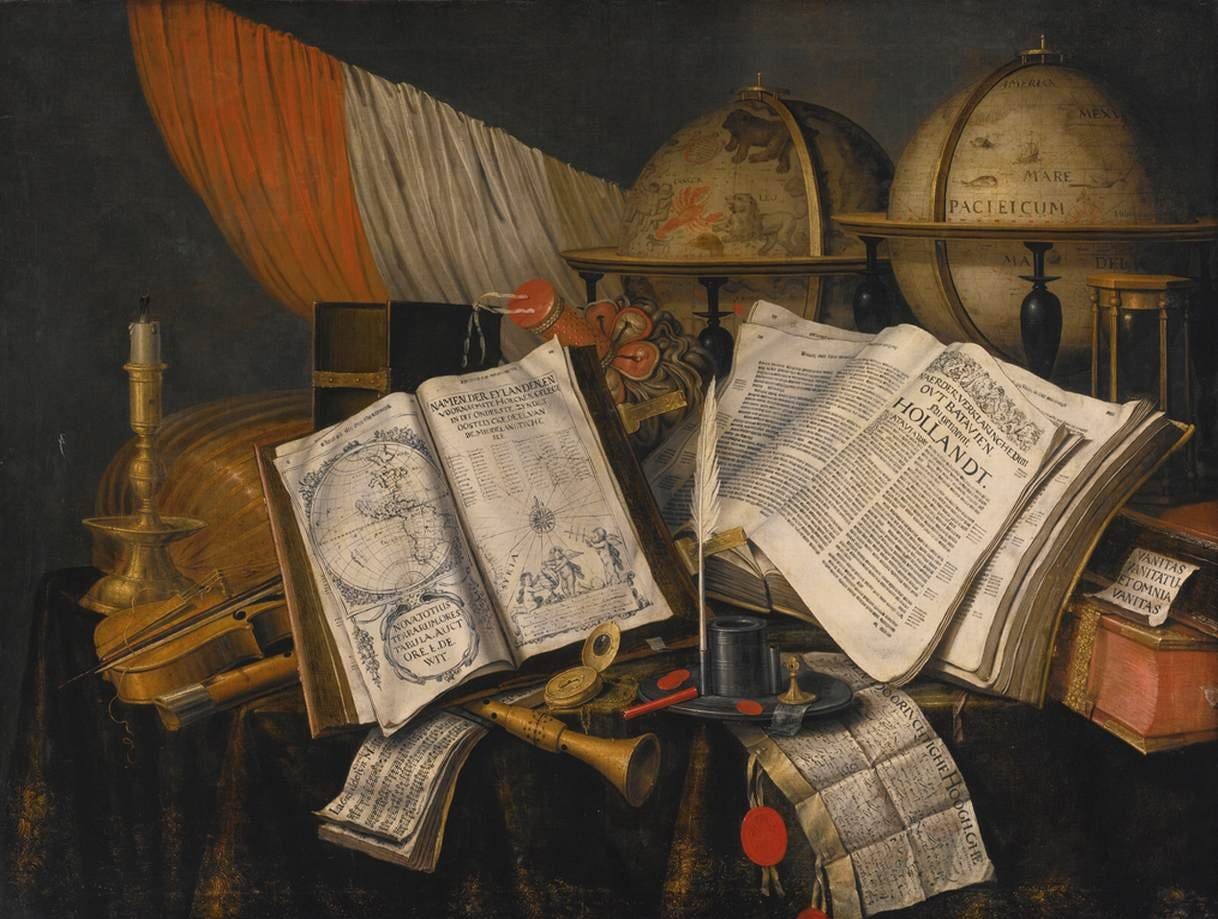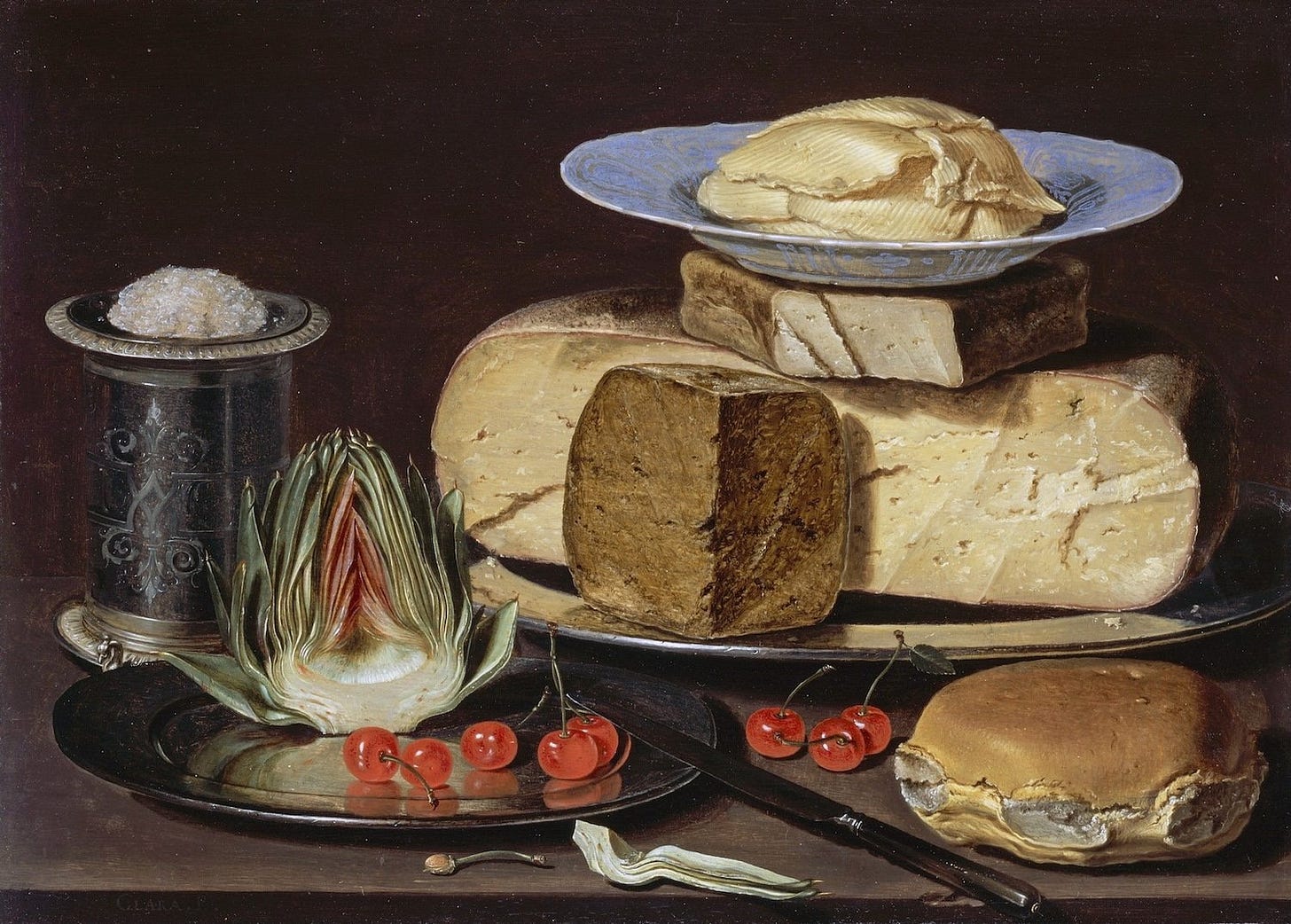These flakey little pies are filled with crispy mushrooms, sweet caramelized onions, and creamy, dreamy gruyere cheese.
I slightly overdid it with the props for the food pics, but it started to remind me of something you’d see in Rijksmuseum in Amsterdam, so I did a deep dive on symbolism in Dutch still life paintings.
Spoiler- if this picture were painted by Clara Peeters back in the 1600s, it would tell a story of temptation, luxury, death, and deliciousness.
Symbolism in Dutch Still Life Paintings
In the late 1500’s, the little lowland country of the Netherlands was experiencing it’s “Golden Age.” An influx of skilled Protestant craftsmen migrated North from Spanish controlled Belgium, cheap energy from windmills and peat, a country wide logistics system of canals, and early trade with Asia positioned the Dutch well for prosperity and great wealth.

In 1602, the founding of the Dutch East India Company marked the first ever multinational corporation. It was, like many of its kind, built on the blood of colonized people and the goods they produced.
The Dutch East India Company and the Dutch West India Company had a monopoly on the spice trade for almost 200 years, and Dutch ships brought more than half a million slaves to the now United States during that time.

These exploits (and many more, including slave labor in Asia, a trade monopoly with previous closed Japan, a Dutch colony now called New York City, and colonization in the Pacific and South America) generated never before seen wealth for merchants in Holland, and coincided with the creation of the Amsterdam Stock Exchange. Being flush with cash, the new class of the rich wanted to adorn their homes accordingly to liven up their homes during the gray Dutch winters, and demonstrate status and culture among their peers.
This is where the still life paintings come in. Rich colors, decadent feasts, rare imports, all juxtaposed against wilting flowers and soft, rotting fruit were some of the popular subject matters for these paintings.
They were called Vanitas, as in the verse from the Book of Ecclesiastes in the Bible: ‘Vanity of vanities, saith the Preacher, vanity of vanities, all is vanity.’

These paintings served as a reminder to a booming Dutch populace that their country was flourishing, yes, but that life was short and success fleeting, and that salvation was the most important goal. They were imbued with rich symbolic meanings, and just as a modern audience knows that a bird flying from its cage represents freedom, and a flower in bloom youth, 17th Century Dutch consumers would have understood that an oyster signifies lust and temptation.
What was fun about this endeavor was realizing that we still do this! So much of modern marketing is focused on communicating the contradictions between abundance and lack. Modern grocery stores, with their shelves perfectly full at all times, the fruit with its best side facing outward. “Haul videos,” where influencers buy an insane amount of stuff and unbox it on camera for millions of viewers.
Someday, will art historians watch GRWM (Get ready with me) videos and comment on the symbolism of different types of lipglosses? Often manufactured in the same places that the Dutch colonized, often with comparably harsh labor practices?
Crispy Cheesy Mushroom Hand Pies
Makes 5-6 hand pies. Easy to double if you’re feeding a big hungry crowd. As usual, I let the experts do the baking. My favorite pie crust recipe is Sally’s!
Ingredients
1 large sweet onion
1/2 green bell pepper
1 tsp olive oil
One 9” pie crust
1/2 lb oyster or button mushrooms
2 tbsp butter
1 c. (or 4 oz.) shredded gruyere
1/2 package of Boursin
Salt and pepper
OPTIONAL- egg to brush onto crust to make it shiny and golden
Process
If you’re making your pie crust from scratch, make and let chill in the fridge.
Get started on the onions and peppers; slice them very thinly and add 1 tbsp neutral oil to a pan on medium-low heat. Once the oil is shimmering, add the onions and peppers and cook, stirring intermittendly for 30-45 minutes. The longer you can go, the better they’ll taste. Add salt and pepper and set aside.
If you’re using store bought pie dough, get it out of the fridge and let it sit on the counter to soften up a bit.
Add 2 tbsp butter to a pan on medium low. Cut up your mushrooms into small pieces and add to the pan. Turn the heat to medium and cook the mushrooms until browned. Don’t add any salt until you’re done cooking; you want the mushrooms to actually crisp up, and if you add salt while cooking, they’ll release their moisture and will be soggy and weird. Don’t do it!
Cook for 5-7 minutes until nicely browned, turn off the heat and set aside.
Combine the mushrooms, peppers, and onions with 1/3 c. Boursin and 1 c. shredded gruyere and set aside while you work on the crust.
Preheat the oven to 400 degrees Fahrenheit. (Yeah I just wrote out Fahrenheit to prove I could spell it, what’s it to you?)
Roll out your pie dough until it’s about 1/8th inch thick. From one 9” pie crust, you should be able to get 5-6 five inch pie crusts. I pressed a cereal bowl into the dough to cut out a perfect circle.
Once you have the circles, lay them out on a parchment lined baking tray. Add equal amounts of the filling to each pie. Fold it over into a half circle, and crimp the edges. I crimped some with a fork, and some with my thumb, and the hand crimped ones performed a lot better and looked prettier.
Cut a slit in the top of each pie with a sharp knife.
If you want the shells to be shiny, you can brush some egg whites on top, but it’s not required.
Cook at 400 for 18-20 minutes, or until the crust is golden brown and flakey. Let cool at least 5 minutes before taking a bite; I made these earlier this week and the roof of my mouth is still messed up. Serve and enjoy!
*These are best warm. To reheat, put on a plate and microwave for 15-20 seconds. Any longer they’ll get soggy.
Further Reading on Dutch Still Life Paintings and the Dutch Golden Age
Symbolism of Still Life Objects
The Little Ice Age: How Climate Made History, by Brian M. Fagan
Dutch Masters: Global Titans of Art
In Dutch Still Lifes, Dark Secrets Hide behind Exotic Delicacies









